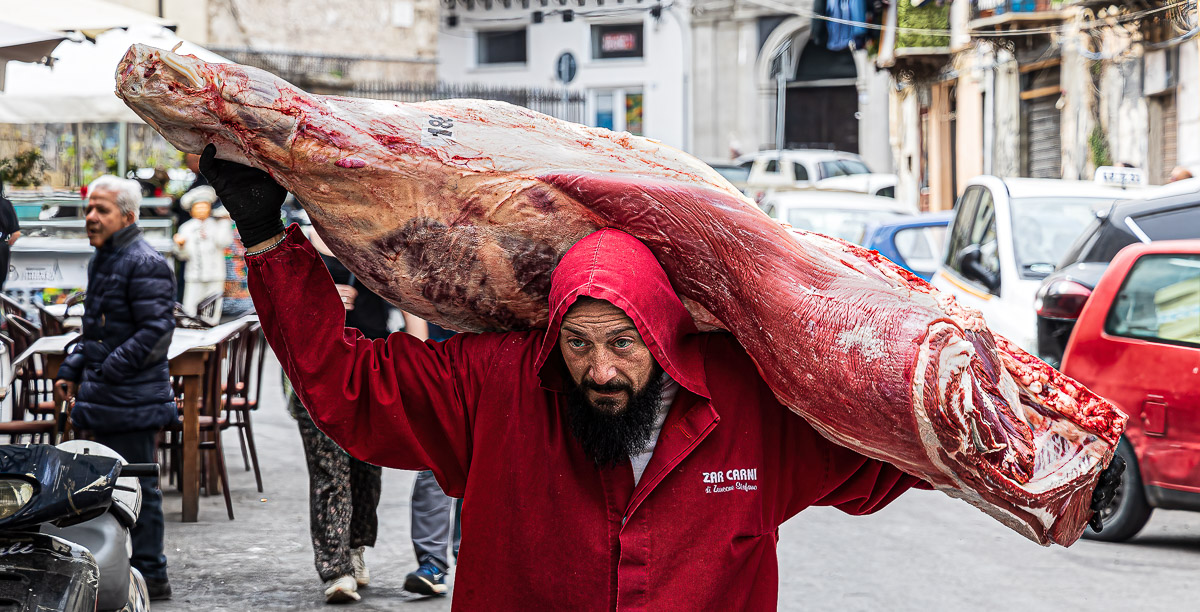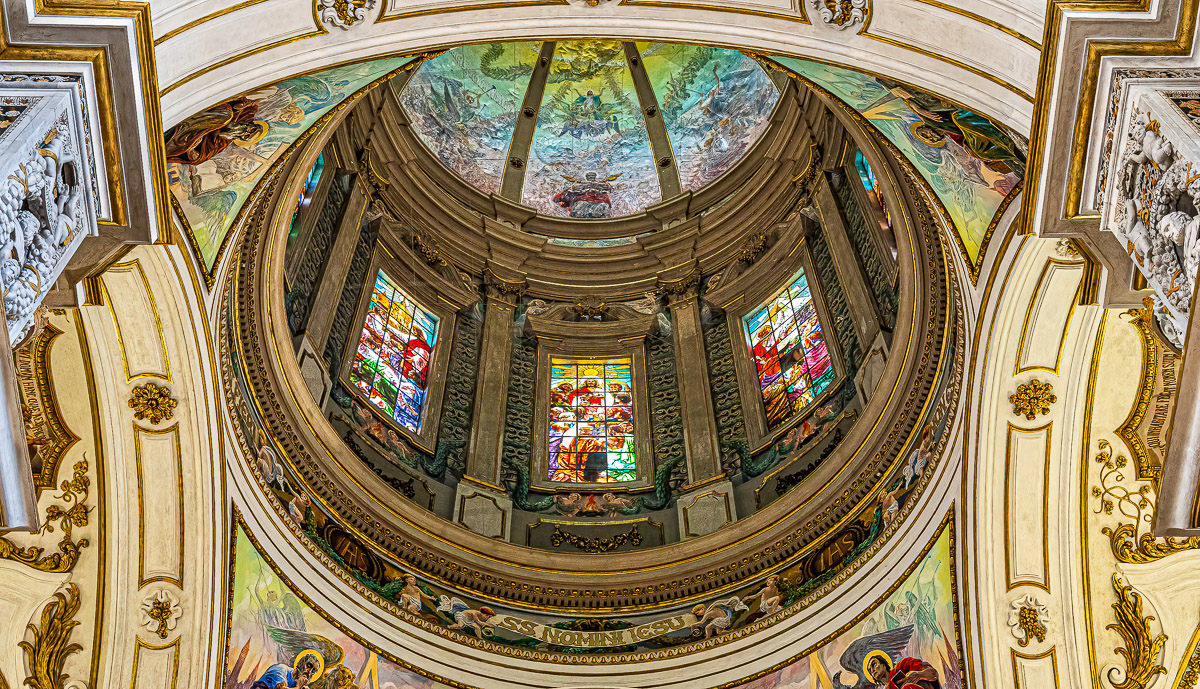Saturday morning — a great time for a walk through one of Palermo’s boisterous street markets. We headed over to the Ballarò Market, the oldest, most authentic and largest of the markets in Palermo. This market originated in the 10th century BCE when the Arabs dominated Sicily, and it still retains some of that atmosphere today. The narrow, crowded streets were full of sounds, colors and smells that pulled my attention in all directions at once. Vendors offered their goods — fresh fruit and vegetables, cheese, meat, fish and more — to potential buyers by shouting or singing of the freshness and quality of what they sold. Their products were spread out on tables and customers gathered around to negotiate prices and look for special deals. Many vendors were selling prepared food for eating at the market. It was like a combination food court and farmers’ market.
Mouse over the small photos in galleries to see captions.
Click on any one to enlarge, then use arrows to scroll through the rest of the images.
It was hard to decide where to look. Since we had to weave through the crowds to keep up with our guide, sticking with the group was quite a challenge. We made a couple brief stops where our guide bought some things for us to eat. I didn’t purchase anything on my own since I didn’t have time to stop and figure out what I might want to try. Boiled octopus or spleen sandwiches did not interest me! One stall was selling pork products and I was surprised to see hog-head halves hanging along with ribs and sausages. Although I grew up on a hog farm, those were things with which I was not familiar. As we were about to leave the market, a man walked past carrying what I could only describe as a side of beef.

Leaving the hectic, noisy, vigorous market behind, we walked a short distance to a quieter, more serene location, the Chiesa del Gesu’ di Casa Professa, one of Palermo’s most noted and beautiful churches. The Jesuits arrived in Palermo in 1549 and this is the first church that they constructed in Sicily. The outside of this church is somewhat typical for a church from this era, but the amazing baroque interior is extraordinary. One guide book says that inside the church the “intricate lace-like decoration and exuberant ornamental stuccoes meld with rich marbles.” I’m not exactly sure what that means, but to me is was ornate to the extreme. You would be hard pressed to find any flat surfaces among the riot of carvings.
Unfortunately, as with many historic buildings in Europe, the Chiesa del Gesu’ was struck by a bomb during World War II. The church’s dome collapsed, destroying most of the surrounding walls and most of the wall paintings in the chancel and transepts. A very long restoration project brought the church back to its original form, after which it finally reopened with a mass on February 24, 2009, presided over by the archbishop of Palermo.

After lunch we boarded a bus for a 30-minute ride to Monreale Cathedral. One of the greatest existing examples of Norman architecture, it was built between 1174 – 1189 by William II of Sicily. This is now an Italian national monument and one of Sicily’s most important attractions. Having seen churches and more churches just two days before and another one this morning, I thought this would be just one more pretty church.
There’s one important difference that sets Monreale Cathedral apart from the other churches we visited. Attached to it is one of the largest and most detailed cloisters in all of Italy. The covered walk around the courtyard is supported by 216 pairs of columns of white marble. Every other pair of columns is decorated with gold and colorful glass patterns. The column capitals are carved with foliage or biblical scenes. An Arabic-style fountain depicting a palm tree sits in one of the corners and across the quad we could see one of the building’s tall square towers. We had not even entered it yet and I was already glad we were visiting one more church.
In case you know as little about some of these church things as I did before this trip, here are a couple clarifications:
(1) A cloister is a covered walk that runs along the walls of buildings forming a quadrangle or courtyard. The attachment of a cloister to a cathedral or church usually indicates that it is part of a monastic foundation. This separates the world of the monks from that of people whose lives and work take place outside the cloister.
(2) A church is not a cathedral because it’s big and beautiful, but because it’s the church in which a residential bishop has his official seat.
Entering the church I was struck by its size and by the amount of gold adorning the walls. The nave is 400 feet long and there are 68,000 square feet of mosaics in the cathedral. Experts estimate that the mosaics were made with 2,200 kg (4,850 lb) of pure gold. In the apse is a 60′ high mosaic of Jesus. He’s holding the gospels in his left hand and holding out his right hand as if offering a blessing. The hand offering the blessing is 6′ high. The is known as the Christ Pantocrator, a largely Eastern Orthodox or Eastern Catholic concept that is less common in the west. The one in Monreale is the largest pantocrator in Europe.
High up along the walls are a myriad of mosaics illustrating biblical stories. I recognized Adam and Eve due to their familiar garb but, despite a thorough description by our guide, I’m afraid I don’t recognize or remember any of the other stories. I’ll leave that up to you. I know I’m not a good enough wordsmith to provide an adequate description, and I doubt I’m a good enough photographer to capture the beauty, but I hope this gives you some idea of what Monreale Cathedral is like.

We drove back to our hotel in Palermo. This was the last day of our Road Scholar trip. Tomorrow we would all be heading our separate ways to California, New York, Texas, Wisconsin and all points between. We had a very nice farewell dinner together in the hotel dining room. Our fearless leader, Enrico Nucci, was there and we all enjoyed talking with him and hearing some of his comments and his stories. He was an excellent trip leader, kept us well informed, and often had us stop for some unexpected treats.
Apparently I had mentioned to one of our group that Kathy and I would be celebrating our 52nd Anniversary in two days. When the waiters brought out the dessert, we were very surprised to see one of the them set a ricotta cheese cake in front of us! On it were two lit candles, one pink and one blue. Then they poured glasses of spumanti and the group sang to us. So, we were able to enjoy a very nice anniversary celebration with our entire group of fellow travelers to Sicily.
Arrivederci Road Scholar Treasures of Sicily!
<— Up to the Mountaintop, Down to the Sea (Sicily Part 11) :: (Sicily Part 13) The Genes in my Jeans —>